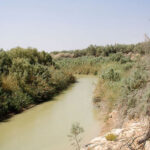The first humans to roam the Earth were nomads, people who wandered from place to place in search of food. It is estimated that about 7,000 years ago, some of these nomads ventured into Mesopotamia, the land between the Tigris and Euphrates rivers. Mesopotamia is also known as the Fertile Crescent. It is called the Fertile Crescent because the swath of land between the rivers looks like a crescent moon and because it is full of rich soil that made growing food easy. The fertile soil, plentiful water, and lush grasses in the Fertile Crescent inspired the nomads to settle in one spot. Thus mankind’s’ transformation from nomad to settler began; here are some of the resulting inventions.
- Shadufs. While the soil in the Fertile Crescent was rich, the climate was arid. In order to farm, water needed to be transported from the Tigris and Euphrates rivers to the land. A piece of equipment called a shaduf was invented to solve this problem. A shaduf scoops water from the river and then swings it to land.
- Clay Tablets. The Mesopotamians invented a form of writing called cuneiform. The Sumerians (a group of people who lived in the southern city of Sumer) learned to write cuneiform on clay tablets. (The plentiful clay was found along the banks of the Tigris and Euphrates rivers.) Temporary messages could be wiped off of wet clay and the tablet reused. Tablets with more important ideas would be baked. These baked clay tablets lasted thousands of years.
- Hammurabi’s Code. Because the Fertile Crescent was a desirable place to live, a lot of nomads settled there. Unfortunately, they did not all get along. There were many wars. Tribal leaders would conquer large portions of Mesopotamia and then control the conquered people by striking fear into them. King Hammurabi from Babylon ruled much of Mesopotamia, but he was different. He attempted to establish rules that people would naturally adhere to. People would do what he wanted because his laws were just, not because they were afraid of the king. These laws (Hammurabi’s Code) were written down in stone. Hammurabi’s Code became the first set of written laws. They were also the first set of laws that were equally enforced on rich,poor, powerful, and weak people alike.
- Sailboats. Mesopotamians flourished by trading goods with each other. It was difficult to move goods over land so they often transported goods on boats along the Tigris and Euphrates rivers. To make controlling the boats easier, the Mesopotamians developed the sailboat. This made steering their goods from port to port easier.
- Libraries. King Ashurbanipal was one of Mesopotamia’s fiercest leaders. He came from the northern part of the Fertile Crescent, called Assyria. Ironically, this fierce king became the world’s first librarian. King Ashurbanipal was inspired by the writings he found on clay tablets that had been found in some of the cities that he had conquered. He ordered that the clay tablets from all of his conquered lands be collected. He was even inspired to have some of his own thoughts and stories written down. He had special rooms built for these tablets and thus, the first library was formed.
Sources:
1. Wise Bauer, S. (2006). The Story of the World. Peace Hill Press.
2. http://history-world.org/sumeria.htm
More from this contributor:
Ancient Roman Developments in Civil Engineering and Time





